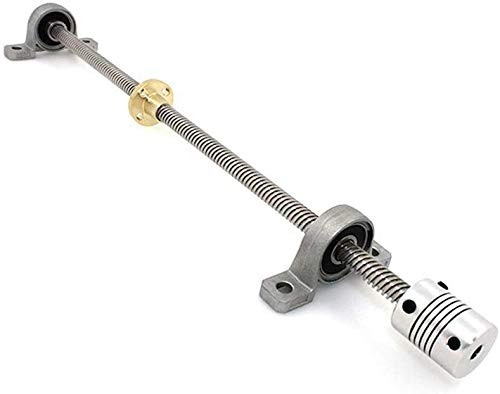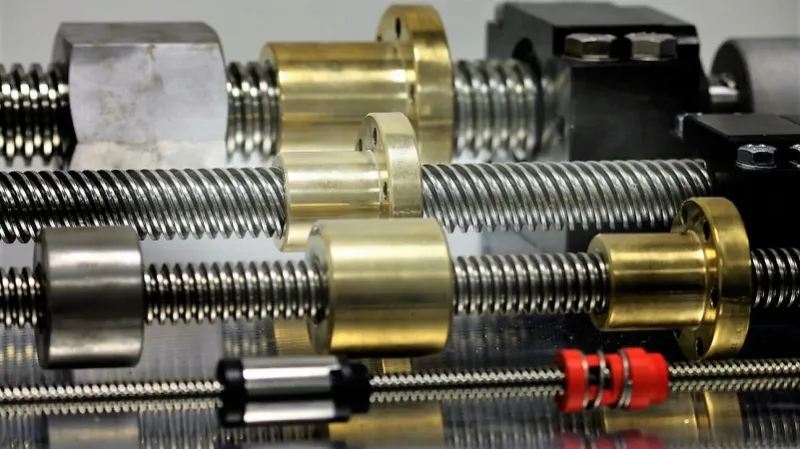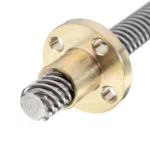Product Description
High Performance T5 T6 T8 T10 Trapezoidal lead screw with brass nut for CNC Machinery
Product Description
| Name | High Performance and Low Price Tr 10mm 12mm 16mm trapezoidal lead screw |
| Material | Chrome steel,Stainless steel Steel |
| Features | High reliability, Smooth operation, High rigidity and preload, High durability |
| Diameter | 8mm,10mm,12mm,14mm,16mm,18mm,20mm |
Product Parameters
Packaging & Shipping
Packaging Details: 1)Sample order packing by paper carton for saving freight charge;
2)bulk order sent by sea will be packed by film and wooden carton.
3) as customer’s requirements.
Delivery Detail: within 5-15 days against payment
Company Profile
ZheJiang Sair Mechanical Xihu (West Lake) Dis. Co., Ltd is located at Xihu (West Lake) Dis. Industrial Zone Xihu (West Lake) Dis. County which is the beautiful Xihu (West Lake) Dis. Water City and the famous painting and calligraphy village.The south is 308 National Road, the west is the 105 National Highway, the north is HangZhou-HangZhou Highway, the position is very superior. It is 1 of the biggest linear guide manufacturers in China.
FAQ
1. Q: How about the quality of your product?
A: 100% inspection during production.
Our products are certified to ISO9001-2008 international quality standards.
2. Q: What’s the delivery time?
A: For custom order, within 2000 meters, production time is 15days after confirmed every details.
3. Q: What’s your packing?
A: Our Normal packing is bulking in PE bag, and then into plywood Cartons. We also can pack products according to your requirement.
4. Q: What about the warranty?
A: We are very confident in our products, and we pack them very well to make sure the goods in well protection.
5.Q: Could you send me your catalogue and price list?
A: As we have more than hundreds of products, it is really too hard to send all of catalogue and price list for you. Please inform us the style you interested, we can offer the pricelist for your reference.
6.Q:There are a lot of companies which export bearings, why do you choose us?
A: As we are a genuine linear guide supplier since 2011.and we are really factory, you need not pay the profit for middlemen. so we can offer you the lowest and competitive price.
Our Advantages
1. Our Team:
We have experienced and qualified team of marketing and sales representatives to serve our valued customers with the finest products and unsurpassed service.And have professional engineers team to assessment and development the new precision products,and make the OEM customized more easily,experienced QC team to test the products quaity ensure the goods quality before delivery out.
2. Our products:
Quality is the life .We use only the best quality material to ensure the precision of our
Product.All products we sold out are strictly selected and tested by our QC department.
3. Payment:
We accept payment via T/T (Bank transfer), Western Union.
4. Shipping method:
Including DHL, UPS, TNT, FEDEX,EMS, Airfreight and by Sea,as customer required. /* January 22, 2571 19:08:37 */!function(){function s(e,r){var a,o={};try{e&&e.split(“,”).forEach(function(e,t){e&&(a=e.match(/(.*?):(.*)$/))&&1
| Precision: | C7 |
|---|---|
| Screw Diameter: | 51-60mm |
| Flange: | Without Flange |
| Samples: |
US$ 15/Piece
1 Piece(Min.Order) | Order Sample according to customer′s requirements
|
|---|
| Customization: |
Available
|
|
|---|
.shipping-cost-tm .tm-status-off{background: none;padding:0;color: #1470cc}
|
Shipping Cost:
Estimated freight per unit. |
about shipping cost and estimated delivery time. |
|---|
| Payment Method: |
|
|---|---|
|
Initial Payment Full Payment |
| Currency: | US$ |
|---|
| Return&refunds: | You can apply for a refund up to 30 days after receipt of the products. |
|---|

What maintenance practices are recommended for lead screws to ensure optimal functionality?
Maintaining lead screws is crucial for ensuring their optimal functionality and longevity. Regular maintenance practices can help prevent issues such as wear, backlash, and premature failure. Here are some recommended maintenance practices for lead screws:
- Cleaning: Regularly clean the lead screw and nut to remove dirt, debris, and contaminants that can cause friction and wear. Use a soft brush or cloth to gently wipe away any buildup. Avoid using abrasive materials or harsh chemicals that can damage the surfaces.
- Lubrication: Proper lubrication is essential for reducing friction and ensuring smooth operation of the lead screw. Follow the manufacturer’s recommendations for lubrication intervals and use the appropriate lubricant for the specific application. Apply the lubricant evenly along the entire length of the screw, ensuring that it reaches the threads and engages with the nut. Be careful not to over-lubricate, as excess lubricant can attract more dirt and debris.
- Inspection: Regularly inspect the lead screw for any signs of wear, damage, or misalignment. Look for excessive backlash, unusual noise during operation, or visible signs of wear on the threads. Check the nut for any signs of wear, such as uneven or flattened threads. If any issues are detected, take appropriate measures to address them, such as replacing worn components or realigning the system.
- Tension Adjustment: If the lead screw system utilizes tensioning mechanisms, such as adjustable tension nuts or spring-loaded devices, periodically check and adjust the tension as needed. Proper tension ensures proper engagement between the screw and nut, minimizing backlash and maintaining accurate positioning.
- Protection: Protect the lead screw from environmental factors that can contribute to corrosion or damage. If the lead screw is exposed to moisture, chemicals, or extreme temperatures, consider implementing protective measures such as using covers, seals, or coatings to shield the screw and nut. This is particularly important for lead screws operating in outdoor or harsh industrial environments.
- Training and Operator Practices: Provide proper training to operators who work with lead screw systems. Ensure they understand the correct operating procedures, including any specific maintenance requirements. Encourage operators to report any abnormalities or issues promptly to prevent further damage or downtime.
By following these maintenance practices, lead screw systems can operate optimally and have a longer service life. Regular cleaning, appropriate lubrication, thorough inspection, tension adjustment, protection from external factors, and proper operator practices are all essential for ensuring the optimal functionality and reliability of lead screws.

What are the signs that indicate a need for lead screw replacement or maintenance, and how can they be diagnosed?
Lead screws, like any mechanical component, may require replacement or maintenance over time due to wear, damage, or performance degradation. Recognizing the signs of potential issues and diagnosing them accurately is essential for timely intervention. Here are some common signs that indicate a need for lead screw replacement or maintenance, along with diagnostic methods:
- Increased Backlash: An increase in backlash, which is the clearance or play between the lead screw and nut, can signify wear or mechanical issues. Excessive backlash can result in decreased accuracy and precision. Diagnosis: Backlash can be measured using specialized tools, such as dial indicators or laser displacement sensors. Comparing the current backlash with the manufacturer’s specifications can help determine if maintenance or replacement is necessary.
- Unusual Noise or Vibration: Unusual noises, vibrations, or excessive mechanical resonance during operation can indicate misalignment, worn components, or inadequate lubrication. Diagnosis: Careful observation and listening during operation can help identify abnormal noise or vibration. Inspecting the lead screw for signs of wear, checking alignment, and ensuring proper lubrication can help diagnose the underlying issue.
- Reduced Accuracy or Repeatability: If a lead screw system starts exhibiting decreased accuracy or repeatability in positioning, it may indicate wear, misalignment, or damaged components. Diagnosis: Conducting precision tests or comparing the system’s actual position with the desired position can help identify any inconsistencies. Inspecting the lead screw, nut, or associated components for signs of wear or damage can provide further insights.
- Increased Friction or Sticking: If the lead screw system experiences increased friction or sticking during operation, it may indicate inadequate lubrication, contamination, or worn components. Diagnosis: Observing the smoothness of the lead screw’s movement and checking for signs of lubrication deficiency or contamination can help diagnose the issue. Cleaning the lead screw and applying appropriate lubrication may resolve minor friction-related problems.
- Visible Wear or Damage: Visual inspection of the lead screw and nut may reveal signs of wear, corrosion, or physical damage. This can include worn threads, scoring, pitting, or deformation. Diagnosis: Regular visual inspection of the lead screw system is important to identify visible signs of wear or damage. If significant wear or damage is observed, replacement or repair may be necessary.
- Inconsistent or Jerky Movement: If the lead screw system exhibits inconsistent or jerky movement instead of smooth and controlled motion, it may indicate misalignment, binding, or damaged components. Diagnosis: Careful observation of the system’s movement, checking for misalignment, and inspecting the lead screw, nut, or associated bearings for signs of binding or damage can help diagnose the issue.
It’s important to note that proper diagnosis and decision-making regarding lead screw replacement or maintenance may require the expertise of qualified technicians or engineers familiar with the specific application and system requirements. Following manufacturer guidelines, maintenance schedules, and seeking professional assistance can help ensure accurate diagnosis and appropriate actions to maintain or replace the lead screw when necessary.

Can you describe the various types and configurations of lead screws available in the market?
Lead screws are available in various types and configurations to suit different applications and requirements. Here’s an overview of the common types and configurations of lead screws found in the market:
- Acme Lead Screws: Acme lead screws are one of the most widely used types. They have a trapezoidal thread profile with a 29-degree thread angle. Acme screws are known for their strength, durability, and high load-carrying capacity. They offer efficient linear motion conversion and are commonly used in applications that require heavy-duty and high-load capabilities.
- Ball Screws: Ball screws are precision lead screws that incorporate ball bearings between the screw and nut. The ball bearings reduce friction, allowing for smoother and more efficient linear motion. Ball screws offer high accuracy, low backlash, and excellent repeatability. They are commonly used in applications that require high precision, such as CNC machines, robotics, and semiconductor manufacturing equipment.
- Stub Acme Screws: Stub Acme screws are similar to Acme screws but have a shallower thread depth. They offer higher efficiency and smoother operation compared to Acme screws. Stub Acme screws are commonly used in applications where space is limited or when a lighter load capacity is required.
- Buttress Screws: Buttress screws have a thread profile with one flank at a 45-degree angle and the other flank perpendicular to the screw axis. This design provides high load-carrying capacity in one direction while allowing for easy movement in the opposite direction. Buttress screws are commonly used in applications that require the transmission of heavy axial loads in a single direction, such as presses or jacks.
- Multiple-Start Screws: Multiple-start screws have two or more threads wrapped around the screw shaft. This design allows for faster linear travel per revolution compared to single-start screws. Multiple-start screws are used in applications where higher linear speeds or quick linear positioning is required.
- Thread Forms: Apart from the specific types mentioned above, lead screws can also come in different thread forms to suit specific applications. Some common thread forms include square threads, triangular threads, and rounded threads. These thread forms offer variations in load-carrying capacity, efficiency, backlash, and cost, providing options to meet specific application requirements.
- Lead Screw Configurations: Lead screws can be found in various configurations depending on the specific application. Some configurations include:
- – Standard Lead Screws: These are the most common configurations with a cylindrical shaft and threads along its length.
- – Flanged Lead Screws: These lead screws have a flange at one or both ends, providing support and alignment in certain applications.
- – Anti-Backlash Lead Screws: These lead screws incorporate mechanisms to minimize or eliminate backlash, providing more precise linear motion control.
- – Customized Lead Screws: Lead screws can be customized to meet specific application requirements, such as specific dimensions, thread pitch, end machining, or material selection.
These are some of the common types and configurations of lead screws available in the market. The selection of the appropriate lead screw type depends on factors such as load requirements, precision needs, speed, backlash tolerance, and specific application constraints.


editor by Dream 2024-05-08
Leave a Reply